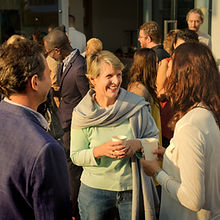The Solution
Putting a Stake in the Ground
Looking at the trends, we should implement a two-pronged approach focused on accommodating the voters across the many regions of the United States. It is time that we begin improving the user experience to increase voter turn-out.

1. Options for Everyone
More than one method to vote
Having a variety of methods to cast one's vote continues to reign king. Convenience was named the top factor in casting votes for 2020 (“3. The Voting Experience in 2020”). One such method we should consider is formalizing the multi-day voting option as Covid-19 concerns left some states offering multi-day polling options.

2. Standardization
One system for all
It is time we begin to recognize that the state-by-state way of handling the voter experience would benefit from simplification and standardization.
"Federal elections are administered by State and local governments, and the specifics of how elections are conducted differ between States. The Constitution and laws of the United States grant States wide latitude in how they administer elections (“Elections and Voting”)."

Expanding on What is Needed
Current methods of voting are:
Absentee ballots (aka, mail-in votes)
In-person Early voting
In-person Election Day voting
Across the United States we should establish a "no excuse required" rule for all absentee ballots. Some states still have a list of statutory reasons in which a person may be allowed to vote by absentee ballot (ie: military duty or persons living overseas) and, as all US citizens have the right to vote, we should minimize the labored process of proving one's reason for casting a vote through the mail. The focus should remain on citizenship and less on the chosen method of casting the vote.
Additionally, some states, such as Virginia, expanded their early in-person voting to begin 45 days out and end 3 days prior to the Election Day (it was lengthened in 2020 due to concerns of crowds during the Covid-19 pandemic). Meanwhile, some states such as Delaware and Missouri do not offer any early in-person voting. This, too, should be an option available to all citizens regardless of which state they reside.
As we continue to evolve with methods for capturing data and analytics so should we also look for testing simplification in the voting process itself. Unclear or intimidating language on ballots continues to be a source of frustration leading to apathy. We should be able to reevaluate how ballots are broadly understood. And, what is holding us back? The legal system. "Because the US operates under the distributed system, each state decides how they want to conduct elections, which has a direct bearing on the voting machines, procedures, and forms used (Quartz)."As we the people who have the right to vote; we should also have the right to clear, streamlined and effective ballots. Addressing this system failure can work within the laws if all states work together to recognize the need of the many. What is required is a team of leaders willing to put aside personal preference. It is time to seek design experts to suggest a universal ballot designed for all.

The time period for early in-person voting varies from state to state.
"Early voting periods range in length from three days to 46 days. The average number of early in-person voting days is 23." We should address this and begin focusing on standardizing this for all 50 states.
"Early In-Person Voting," National Conference of State Legislatures, 17 November 2021. https://www.ncsl.org/research/elections-and-campaigns/early-voting-in-state-elections.aspx

Removing all statutory reasons from absentee ballots will open up
this method of voting for all citizens.
How
Steps to Implementation
"The dispersed responsibility for running elections also makes it extremely difficult, if not impossible, to rig U.S. elections at the national level. It also holds authorities in local jurisdictions accountable for the management of their own elections, so if something goes wrong citizens can go directly to their local government rather than blame problems on the distant federal government
(National Conference of State Legislatures)."

Start with the Voter
Voter endorsement leads
to action
Create a political action committee (PAC) that focuses on getting out information through it's website, advertisements, hand-written postcards, and polling place hand-outs informing voters as to how they can help persuade their local election official to move toward a national standard. The PAC creates a form in which individuals can enlist as a supporter of the enhanced ballot initiatives. The PAC also works to gather voter endorsement of their actions so they can then address legislation.
Time estimate: Setting up and formalizing the PAC; up to 1 year. Creating materials and gaining momentum with voters; 1-2years+.

Take it to the state election office
Keep it bi-partisan
Gaining buy-in from local election offices, and its identified members, can help continue the momentum needed to then address representatives to help draft a bill for legislation. The bill will focus on asking for a federal standard for early in-person voting, removing of absentee ballot statuary restrictions and seeking a design committee to create a more universal ballot that can be widely used across all 50 states.
Time estimate: Creating materials and gaining momentum with election offices; 1-2years+. Drafting a bill with legislation; 6mo's - 1year.

Legislative vote
Enacting the bill
Continuing to strengthen the communication between Legislators and local election officials is key in the effectiveness for officials to see the big picture uniformity and simplification across all the states will bring. Presenting analytics that highlight how misalignment creates more paperwork and hours on the back-end will be key in pushing these simplification measures through.
Time estimate: Pulling together analytics; 6+ months. Establishing communication touch points; 6+ months. Establishing a design committee to create mock-ups as needed for buy-in, 6mo's - 1year.
Sources
“3. The voting experience in 2020” Pew Research Center, 20 November 2020, https://www.pewresearch.org/politics/2020/11/20/the-voting-experience-in-2020/#convenience-was-top-factor
“Elections and Voting” The White House, https://www.whitehouse.gov/about-the-white-house/our-government/elections-and-voting/
"2020 Session: HB 1 Absentee voting; no excuse required, voting by absentee ballot." Virginia's Legislative Information System, https://lis.virginia.gov/cgi-bin/legp604.exe?ses=201&typ=bil&val=hb1&ses=201&typ=bil&val=hb1
"Absentee Ballot Rules," Vote.org, https://www.vote.org/absentee-voting-rules/
"Why it’s so hard to fix America’s poorly-designed election ballot," Quartz, https://qz.com/1917588/why-the-us-absentee-ballot-is-so-poorly-designed/

